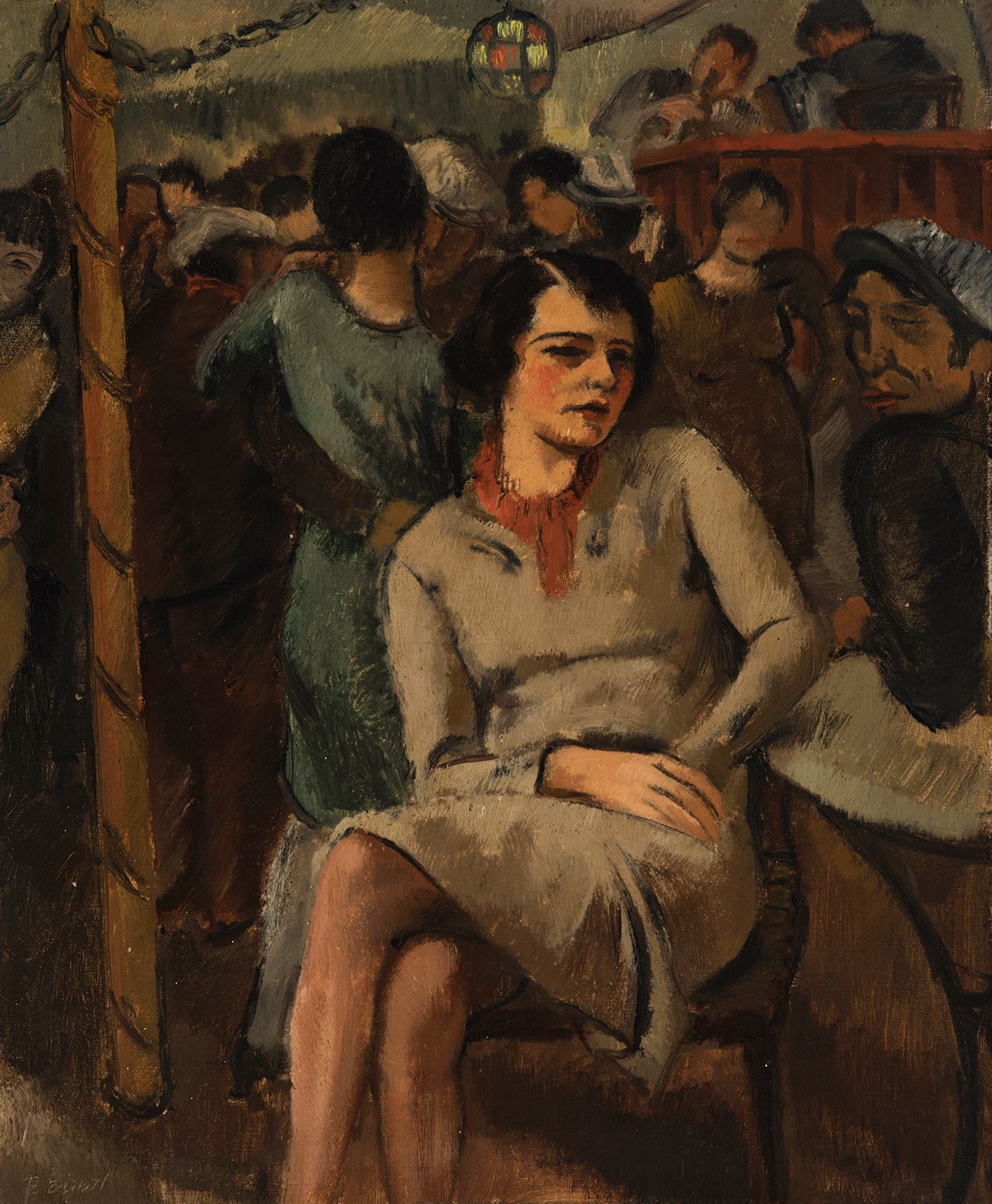Description
FRANÇOIS ELBERT (May 25, 1887 - October 8, 1962) "Bal Musette II, 1931. Oil on canvas. Attached certificate of authenticity issued by Madame de Chaudum, 1978. Work referenced in the artist's catalogue raisonné. NO. G458. Provenance; Work exhibited at Sazek Gallery, Prague (1934); Contini Galería de Arte, Caracas, acquired in 1978. Madrid Collection. Size: 55 x 46 cm; 75 x 66 cm (frame). Portrait of a lady of great instantaneity, similar to a fleeting vision captured from life, rather than a portrait calmly drawn in a studio. The woman, in fact, is not posing and does not seem to be aware of our gaze, but appears with her body in front and her face in profile, looking towards something beyond the painting, hidden from our view. Nevertheless, the composition is typical of the period, inspired by bohemian life and café scenes in which the figures are isolated and meditative despite being in a crowd. Eberl's artistic talent was evident from the outset: in 1903 he was admitted to the local Academy of Fine Arts. His artistic temperament, however, was incompatible with the Academy's conservative tradition, so he left Prague and travelled around Europe. In October 1904, Eberl arrived in Munich and enrolled at the Academy of Fine Arts. Soon, Eberl became a professor at the Academy himself; however, the negative response to his publication of some political drawings critical of the Bavarian nobility caused Eberl to leave Germany. In 1911 Eberl settled in the artists' quarter of Montmartre and began to exhibit his works in the famous Parisian salons of the time. In 1914 he joined the Czech legion and fought alongside the Allies. Despite the war raging in Europe, Eberl's works were seen in numerous exhibitions. During the 1920s, his career took off, the legendary art dealer Berthe Weill took an interest and included him in numerous exhibitions at her Paris gallery, and Eberl became a member of the Salon des Artistes Independents. In 1928 Francois Eberl was awarded the Legion of Honour by the French government. After the Second World War, Eberl returned to his Parisian studio on Rue Camille Tahan and, inspired by the folklore of Paris, his preference was to paint street scenes and nightclubs as he observed them. Eberl was interested in capturing the marginalised lives of the poor in the shadows of glittering Paris. Eberl's paintings in Monmartre are the embodiment of a social milieu at a given time: the evocation of bohemian Paris, a mythical place at a time when even the streets had a certain grandeur and romantic spirit. In addition, Eberl had a distinctive colour palette that made generous use of earth tones of browns and reds.
68
FRANÇOIS ELBERT (May 25, 1887 - October 8, 1962) "Bal Musette II, 1931. Oil on canvas. Attached certificate of authenticity issued by Madame de Chaudum, 1978. Work referenced in the artist's catalogue raisonné. NO. G458. Provenance; Work exhibited at Sazek Gallery, Prague (1934); Contini Galería de Arte, Caracas, acquired in 1978. Madrid Collection. Size: 55 x 46 cm; 75 x 66 cm (frame). Portrait of a lady of great instantaneity, similar to a fleeting vision captured from life, rather than a portrait calmly drawn in a studio. The woman, in fact, is not posing and does not seem to be aware of our gaze, but appears with her body in front and her face in profile, looking towards something beyond the painting, hidden from our view. Nevertheless, the composition is typical of the period, inspired by bohemian life and café scenes in which the figures are isolated and meditative despite being in a crowd. Eberl's artistic talent was evident from the outset: in 1903 he was admitted to the local Academy of Fine Arts. His artistic temperament, however, was incompatible with the Academy's conservative tradition, so he left Prague and travelled around Europe. In October 1904, Eberl arrived in Munich and enrolled at the Academy of Fine Arts. Soon, Eberl became a professor at the Academy himself; however, the negative response to his publication of some political drawings critical of the Bavarian nobility caused Eberl to leave Germany. In 1911 Eberl settled in the artists' quarter of Montmartre and began to exhibit his works in the famous Parisian salons of the time. In 1914 he joined the Czech legion and fought alongside the Allies. Despite the war raging in Europe, Eberl's works were seen in numerous exhibitions. During the 1920s, his career took off, the legendary art dealer Berthe Weill took an interest and included him in numerous exhibitions at her Paris gallery, and Eberl became a member of the Salon des Artistes Independents. In 1928 Francois Eberl was awarded the Legion of Honour by the French government. After the Second World War, Eberl returned to his Parisian studio on Rue Camille Tahan and, inspired by the folklore of Paris, his preference was to paint street scenes and nightclubs as he observed them. Eberl was interested in capturing the marginalised lives of the poor in the shadows of glittering Paris. Eberl's paintings in Monmartre are the embodiment of a social milieu at a given time: the evocation of bohemian Paris, a mythical place at a time when even the streets had a certain grandeur and romantic spirit. In addition, Eberl had a distinctive colour palette that made generous use of earth tones of browns and reds.
